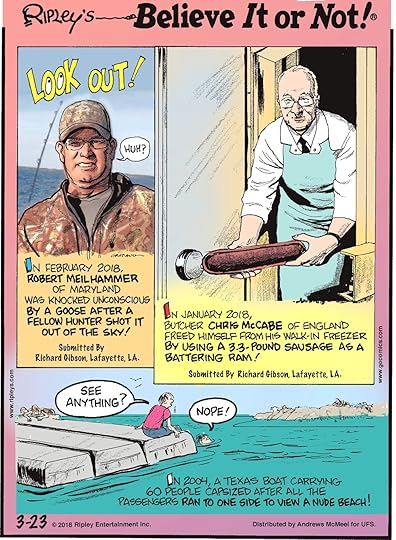Ripley Entertainment Inc.'s Blog, page 354
March 25, 2018
CARTOON 03-25-2018
March 24, 2018
CARTOON 03-24-2018
March 23, 2018
Mike The Headless Chicken Will Leave You Asking “What The Cluck?!”
Featured in Ripley's Believe It or Not!

The idiom “running around like a chicken with its head cut off” is commonly used, alluding to the fact that the body of a chicken whose head has been cut off often frantically flounders about before succumbing to its fate. Well, not all chickens can relate. Mike, survived 18 headless months!
Miracle Mike
On September 10, 1945, farmer Lloyd Olsen chopped off 5 1⁄2-month-old Mike’s head with an ax in readiness for the cooking pot. Believe it or not, the headless rooster continued pecking for food around his Fruita, Colorado, farm!
Olsen decided to spare Mike and, over the next 18 months, they toured the country.
Dubbed “Miracle Mike,” sideshow promoter Hope Wade insured the bird for $10,000 and charged 25 cents for a peek.
But How Was Mike Surviving?
Although most of his head was in a jar, part of his brain stem and one ear remained. Since the majority of a chicken’s reflexes are controlled by the brain stem, Mike was able to function relatively normally.
It is estimated that up to 80% of his brain by mass remained untouched. Due to this, the fact that he was able to continue functioning is much easier to explain than the fact that he didn’t bleed to death…
The Accident
Unfortunately, after a year and a half in the limelight, Mike’s life came to an end.
Mike was fed grain and water dropped directly into his esophagus with an eyedropper, but a syringe was also needed to clear his throat.
On that fateful evening, Mike began choking and Lloyd could not find the syringe used to clear his throat. Before Lloyd could come up with an alternative, Miracle Mike suffocated.
Source: Mike The Headless Chicken Will Leave You Asking “What The Cluck?!”
Bone Mutations Found In Ata Boy Skeleton’s DNA
Featured in Ripley's Believe It or Not!
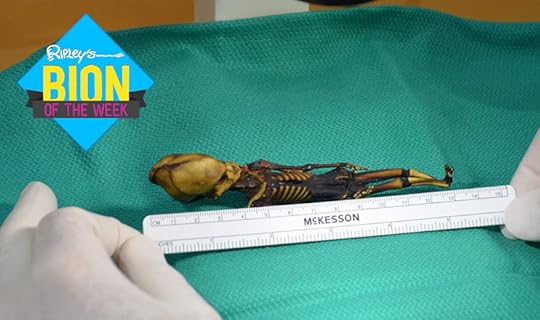
[March 18-24th, 2018] A couple took an accidental photo together years before they met, a gorilla likes to keep his hands clean, and new evidence explains the origins of the mysterious Atacama mummies.
Love at First Photo
A married couple in China recently found a photo of the two years before they would ever meet and fall in love. Both visiting the May 4th Monument in Qingdao, husband Mr. Ye can be seen posing in the background of his wife’s photo. The two were stunned to learn of their close encounter, comparing each other’s photos closely.
Married couple in China discover they appeared in same photograph as teenagers: Report https://t.co/n0OLNxKbUi pic.twitter.com/vrSlECRRmP
— Channel NewsAsia (@ChannelNewsAsia) March 11, 2018
.
Prim Primate
Louis, a western lowland gorilla at the Philadelphia Zoo, has earned the reputation of being a clean freak. With a habit of walking upright, the Zoo suggests he does so to keep from getting his hands dirty. In fact, they’ve noticed Louis hates mud, running for shelter bipedally when it rains and even using leaves and plastic bags to wipe off his feet.
Bearded Lady Lion
Last spring, an African lioness a the Oklahoma City Zoo sprouted a beard. While male lions are typically known for their manes, females don’t usually grow them. They expected her testosterone levels to be high, but they weren’t. Now, a year later, they’ve determined it’s likely due to a tumor increasing her levels of androstenedione.

By Amanda Sorenson, via Oklahoma City Zoo.
Baking Out of Control
Cedric Vaivre, a 41-year-old French baker was fined $3,700 for refusing to take a day off. Going against the country’s labor laws, he kept his shop open seven days a week over the summer. He and the mayor insist the shop needed to be open to service tourists, but local decrees only allow bakeries to operate six days a week.

Atta Boy
Though we lost our own Atta Boy in the early days of Ripley’s history, another similar specimen has been in the news for the last two decades. While this one has been the subject of sensational documentaries and web drama, it was proven in 2013 to be human. Mysteriously, its six-inch stature didn’t match the apparent 6-year-old bone density. New testing has shown the genes of the skeleton contain mutations that accelerated bone growth, meaning it is likely a miscarried fetus, just as Robert Ripley guessed his was.

By Dr. Emery Smith/via CSH Press
CARTOON 03-23-2018
March 22, 2018
Salem Never Burned Any Witches At The Stake
Featured in Ripley's Believe It or Not!

Or Not
In today’s world many misconceptions have been perpetuated—becoming modern day “facts”—when, in reality, myths and hearsay have taken over. Sorry to burst your bubble, but in this weekly column, Ripley’s puts those delusions to the test, turning your world upside down, because you can’t always…Believe It!
Today: No witches were burned in Salem.
Salem Witch Trials
The Salem Witch Trials are perhaps the most infamous series of literal witch hunts in history, but did Puritans really tie these suspected supernaturals to stakes and light them ablaze?
Burning witches is almost as synonymous with New England as lobster, but the iconic image of a poor woman being burned to death at the stake by the hands of Puritans in America is completely false. Not a single witch was burned during the Salem Witch Trials. With the exception of one witch, they were all hanged by the neck until dead or died while in prison.
The witch hunt began after three girls—Betty Parris, Abigail Williams, and Ann Putnam—began experiencing “fits.” Writhing on the ground and speaking non-sense, Betty’s father, a reverend, along with doctors claimed the girls were bewitched.
The girls were interrogated to find out who could possibly have bewitched them, and they pointed their fingers at the family’s black slave from Barbados—named Tituba—along with two elderly women.
Under pain of torture, the accused pointed their fingers at others, as well. Tituba is recorded to have said that the devil approached her directly. The village put together a special court to investigate the witches, and before the end of the year, had hung 19 people and put over a hundred in jail.
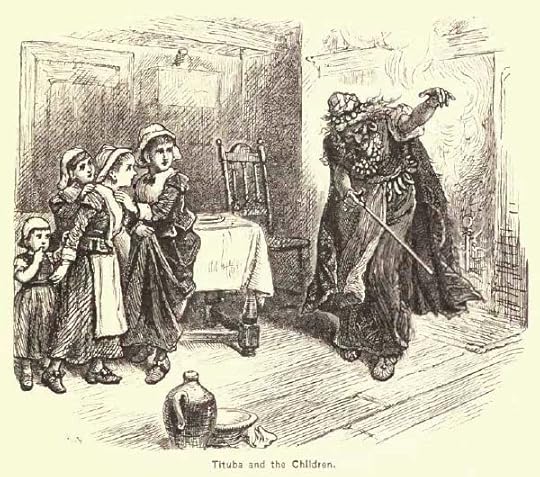
A later depiction of Tituba.
Giles Corey
While this hunt may seem to be a frantic bout of sensationalism, there are some reasons to believe it was the malicious plans of Thomas Putnam and Samuel Parris. Both were merchants, but Parris was also the village’s reverend. The way these trials worked, a convicted witch had their property confiscated and given to the church.
Remember the one witch we mentioned who wasn’t hanged?
Giles Corey was a relatively wealthy farmer. Though he was initially swept up in the fervor of the trials—even testifying against his own wife—his attitude changed when his rival’s daughter accused him of consorting with the devil.
Corey knew the court was after his property and refused to plead either guilty or innocent. Like they had done before, the court tried torturing a confession out of him. Sandwiching him between two planks on the ground, they began stacking rocks on the silent victim, trying to literally squeeze the truth out. Corey lasted until the weight killed him and is even rumored to have yelled at torturers to add more weight.
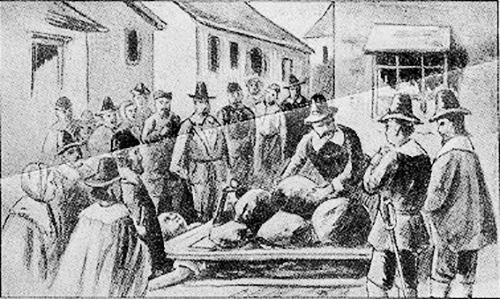
Ending the Hunt
By the fall of 1692, the neighboring city of Boston railed against the lunacy of Salem’s witch trials. Governor William Phips finally intervened when his wife became suspected of witchcraft. He suspended the witch task force, establishing a new court. This Superior Court of Judicature eventually cleared 53 of the remaining 56 defendants and pardoned the remaining three along with five other “convicted” sorcerers bound for Gallows Hill.
While nobody was burned alive in colonial America, the practice was far more common in Catholic Europe. There, witches and blasphemers convicted of “heinous” crimes could be executed by burning, but more often, they were killed another way followed by flames to prevent further dark magic. At this time in history, however, British Law reserved burning for people convicted of treason.
CARTOON 03-22-2018
March 21, 2018
The Oddity Of Neuroscience: Phineas Gage
Featured in Ripley's Believe It or Not!

When 25-year-old Phineas Gage went into the Vermont wilderness to work as a railroad foreman in 1848, he had no idea that his story would show up in psychology textbooks for the next 150 years.
Using an iron tamping rod to pack explosives into rock—an everyday task—the charge went off prematurely. The 3-foot long, inch and a quarter rod tore through Gage’s head. The 13-pound rod entered his jaw, passed behind his eye, and exited the top of his skull before flying into the sky and landing 80 feet away.
Gage didn’t just survive this horrible accident, but may not have even passed out.
“Here is business enough for you.” -Gage to his doctor.
 Cared for by Dr. John Martin Marlow, Gage was able to recover, at least physically. He lost his left eye, but according to friends and family, he lost something else: himself. Once known as a model worker and mild-mannered man, Gage became disrespectful and impetuous. The railroad refused to hire him back, and Dr. Marlow wrote that he was “no longer Gage.” He would utter profanities constantly and was reported to be generally intolerable by anyone.
Cared for by Dr. John Martin Marlow, Gage was able to recover, at least physically. He lost his left eye, but according to friends and family, he lost something else: himself. Once known as a model worker and mild-mannered man, Gage became disrespectful and impetuous. The railroad refused to hire him back, and Dr. Marlow wrote that he was “no longer Gage.” He would utter profanities constantly and was reported to be generally intolerable by anyone.
Dr. Marlow took special note of this behavior change as a student of the budding pseudo-science of phrenology. Phrenology sought to determine the faculties associated with different areas of the brain. Claiming to be the founder of phrenology, Franz Joseph Gall claimed that the brain was made up of 27 individual organs that decided your personality and that animals could only have 19 of these organs.
While the specifics of phrenology were entirely off-base (there is no “talent for poetry” organ) it did cause many men of science to pay attention to Gage’s behavior and link his outward changes to the damage done to his brain. Though enigmatic, neuroscientists today do believe the frontal lobe plays an important role in behavior.
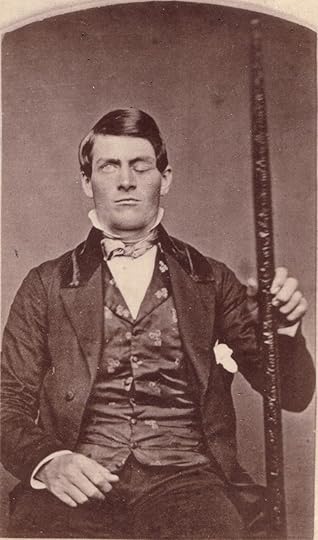
Gage and the recovered rod.
A Changed Man
While Gage’s story is often cited as permanent, doctors encountering him years later made no record of his outward behavior, bringing into question the long-lasting effects of his trauma, or whether his attitude change was a complete fabrication.
Gage was weakened for years after his injury, returning home to New Hampshire to do light farm work with his family. He made appearances in Boston, either paraded in front of doctors in medical schools or gasping observers at P.T. Barnum’s American museum.
In 1852, he traveled to Chile to work as a stagecoach driver. After a few years, he began having seizures and died at age 37. Dr. Harlow hadn’t spoken to Gage in years, but upon hearing of his former patient’s death, he exhumed Gage’s skull, eventually giving it to the Warren Medical Museum at Harvard.
Rotten Sneaker Contest Chooses Odorous Winner
Featured in Ripley's Believe It or Not!

Six young participants from across the country, New York to Alaska, smelled it out for the country’s stinkiest sneaker. Despite an array of worthy contenders, only one pair of shoes could walk away the smelliest. Competing to win the 43rd national title in the Odor-Eaters Rotten Sneaker contest, six competitors and 12 sneakers made their way to the Ripley’s Believe it or Not! Odditorium in Times Square.
Sneakers were judged on odor, condition, and the child’s personal description of why their sneakers were simply the stinkiest. The esteemed panel of judges included NASA “Master Sniffer” George Aldrich, Chemical Specialist for NASA space missions and expert author on the psychology of smell, Rachel Herz, Ph.D., and a reporter with a nose for the news, Huffington Post’s Buck Wolf.

Participants trained hard to win over the judges, traipsing through all the sorts of messes your average kid encounters throughout the year.The Odor-Eaters Rotten Sneaker Contest is the ultimate proof of how truly offensive kids’ sneakers can get when they are playing outdoors, splashing through puddles, slogging through mud, and more. Last year’s winner owed his prize to a plethora of fishing trips and work on his aunt’s farm.
This year’s winning pair of sneakers belonged to 8-year-old, Hunter Hamm, from Eagle River, Alaska who took home $2,500, won an extra two-night stay in New York City to see The Lion King, and the Golden Sneaker Award. A combination of fishing, skateboarding, biking, and work in the chicken coop helped Hunter edge out the competition. His shoes will be enshrined in the venerable Hall of Fumes, cementing their place in the smelly annals of history.
Smell expert and judge Rachel Herz notes that what people find the most foul smelling is subjective, but that fish, poop, and sweat were on most people’s list of bad smells.
“He had the trifecta of terrible.” —Rachel Herz

Though only six finalists came to Ripley’s Times Square, other odorous hopefuls all around the country competed in local competitions to earn their ticket. Absent of embarrassment, each competitor proudly wore their shoes to the final smelling, handing their shoes—fresh off their feet—to judges for a thorough sniffing. A smelly interior alone wasn’t enough, as the exterior was also graded for “presentation.”

The Odor-Eater’s Rotten Sneaker Contest began in 1974 as a promotion created by a Montpelier, Vermont, sporting goods owner looking to advertise a new line of athletic shoes. At the Montpelier Department of Recreation, the owner discovered a photogenic pair of very smelly sneakers perfect for the store ad and the rest is history. Odor-Eaters joined the foot fray in 1988 as the official sponsor, offering their products to any and everyone whose shoes could use some freshening up.
We’re not sure what Hunter plans to spend his newly-won money on, but we hope he decides to pick up a new pair of shoes!
CARTOON 03-21-2018
Ripley Entertainment Inc.'s Blog
- Ripley Entertainment Inc.'s profile
- 52 followers




